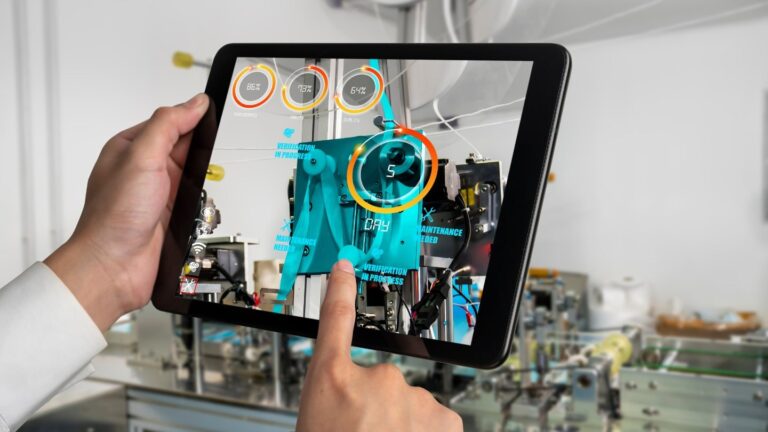
In the fast-paced world of e-commerce, creating an engaging and memorable customer experience is crucial for brands seeking to stand out in a crowded marketplace. One transformative technology making waves in this sector is augmented reality (AR). AR is revolutionizing how e-commerce brands showcase their products, turning passive browsing into interactive and immersive experiences. This article delves deep into the impact of AR on product demos, exploring its benefits, challenges, and future potential
The Rise of Augmented Reality in E-commerce

1. What is Augmented Reality?
Augmented reality overlays digital elements—such as images, sounds, and other data—onto the real world, enhancing the user’s perception of their surroundings. Unlike virtual reality (VR), which creates a completely immersive virtual environment, AR blends digital components with the physical world, often through smartphones, tablets, or AR glasses.
2. Why AR Matters in E-commerce
The global e-commerce market is fiercely competitive, and shoppers are increasingly looking for engaging and convenient ways to interact with products online. AR bridges the gap between physical and digital shopping experiences by allowing customers to visualize products in their environment before purchasing. This not only enhances customer confidence but also reduces the uncertainty and risk often associated with online shopping.
How AR is Transforming Product Demos

1. Enhanced Visualization
One of the primary challenges of online shopping is the inability to see, touch, or try products before purchasing. AR solves this problem by enabling customers to visualize products in their own space.
- Furniture and Home Decor: IKEA’s AR app, IKEA Place, allows users to place virtual furniture in their homes to see how it fits and looks with their existing decor.
- Beauty and Fashion: Brands like Sephora and MAC use AR-powered apps to let customers try on makeup virtually, ensuring they find the perfect shade or style.
2. Interactive and Personalized Experiences
AR takes product demos beyond static images and videos, offering interactive and tailored experiences.
- Product Customization: AR tools let customers modify product colors, materials, or features in real-time. For example, Nike’s app allows users to customize shoes and see how the designs will appear.
- Virtual Try-Ons: Fashion retailers like ASOS and Warby Parker use AR to let shoppers virtually try on clothes, glasses, or accessories, improving fit and style selection.
3. Gamification of Shopping
AR introduces an element of fun and engagement into the shopping journey.
- In-store AR Games: Brands like Pokémon Go-inspired campaigns to drive foot traffic to physical stores while promoting specific products.
- AR Treasure Hunts: Retailers use AR to create digital scavenger hunts, encouraging customers to interact with products and earn rewards.
4. Real-time Product Demonstrations
Through AR, brands can simulate how products work in real-world scenarios.
- Electronics and Gadgets: Samsung and Apple have used AR to demonstrate the features of their latest smartphones, enabling users to interact with virtual models.
- Automotive Industry: Companies like Tesla use AR to showcase car interiors, exteriors, and key functionalities.
Benefits of AR Product Demos

1. Improved Customer Engagement
AR keeps users on a brand’s platform longer by providing a unique and captivating experience. The novelty of AR attracts customers, while the interactivity sustains their attention.
2. Increased Conversion Rates
When customers can visualize products in their context, their confidence in purchasing rises, leading to higher conversion rates. According to a study by Deloitte, AR experiences can increase purchase intent by 20%.
3. Reduced Returns
By providing a realistic preview of products, AR helps shoppers make informed decisions, which can significantly reduce return rates. For instance, virtual try-ons ensure better sizing and styling choices in fashion.
4. Enhanced Brand Perception
Brands that adopt AR are often perceived as innovative and customer-centric, which can boost loyalty and attract tech-savvy audiences.
Challenges in Implementing AR for E-commerce

1. High Development Costs
Creating AR applications and features requires significant investment in technology, development, and maintenance. For smaller brands, this can be a barrier.
2. Technical Limitations
Not all customers have devices capable of running AR applications smoothly. Limited internet bandwidth or outdated smartphones can hinder the AR experience.
3. Complexity of Integration
Seamlessly integrating AR into existing e-commerce platforms and ensuring compatibility across devices can be challenging for brands.
4. User Adoption
While AR is growing in popularity, some customers may be hesitant to adopt the technology due to unfamiliarity or privacy concerns.
Future Trends in AR Product Demos

1. AR Shopping Glasses
As wearable AR technology like Apple Vision Pro and Magic Leap advances, shoppers may soon experience immersive product demos without relying on smartphones or tablets.
2. AI-Driven AR Experiences
The integration of artificial intelligence (AI) with AR will enable hyper-personalized shopping experiences, tailoring product recommendations and visualizations to individual preferences.
3. AR in Social Commerce
Social media platforms are increasingly incorporating AR features, allowing brands to offer AR product demos directly on apps like Instagram, Snapchat, and TikTok.
4. Augmented Reality in the Metaverse
The metaverse—a virtual universe combining AR and VR—holds vast potential for e-commerce. Brands could create virtual storefronts where customers can explore and interact with products in a fully digital space.
Conclusion

Augmented reality is no longer a futuristic concept; it’s a powerful tool reshaping the e-commerce landscape today. By transforming product demos into interactive, immersive experiences, AR is bridging the gap between online and offline shopping, building customer confidence, and driving sales.
For e-commerce brands, investing in AR technology isn’t just about keeping up with trends—it’s about staying ahead of the curve in a rapidly evolving market. As AR technology continues to advance, the opportunities for innovation in product demonstrations are limitless. By embracing AR, brands can create unforgettable shopping experiences that captivate audiences and drive long-term growth.






















